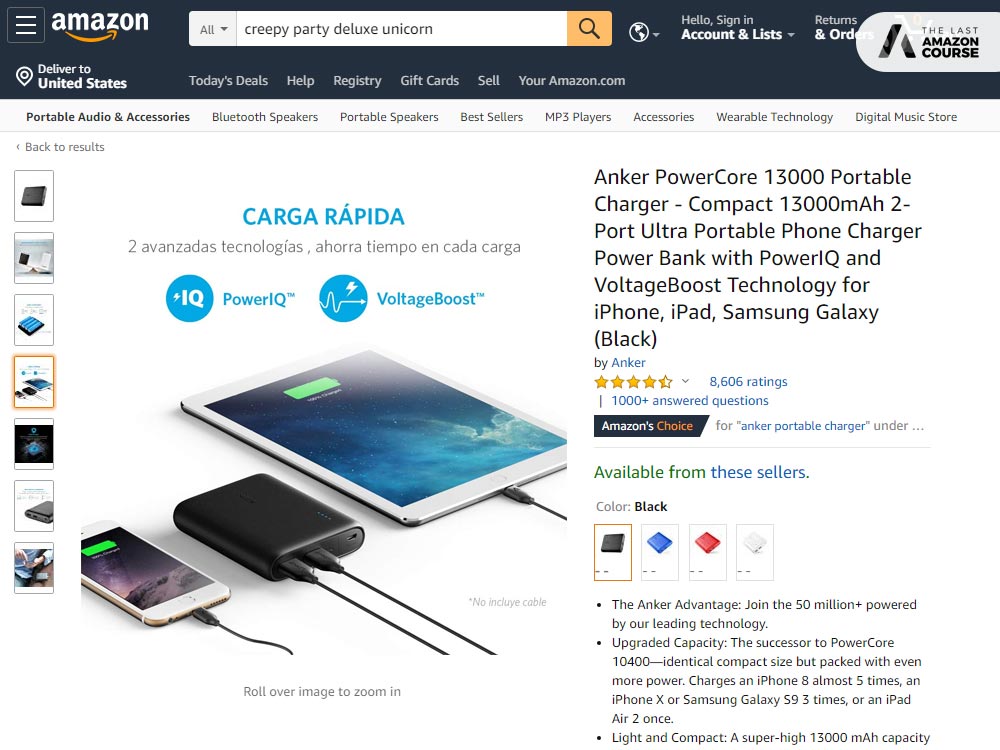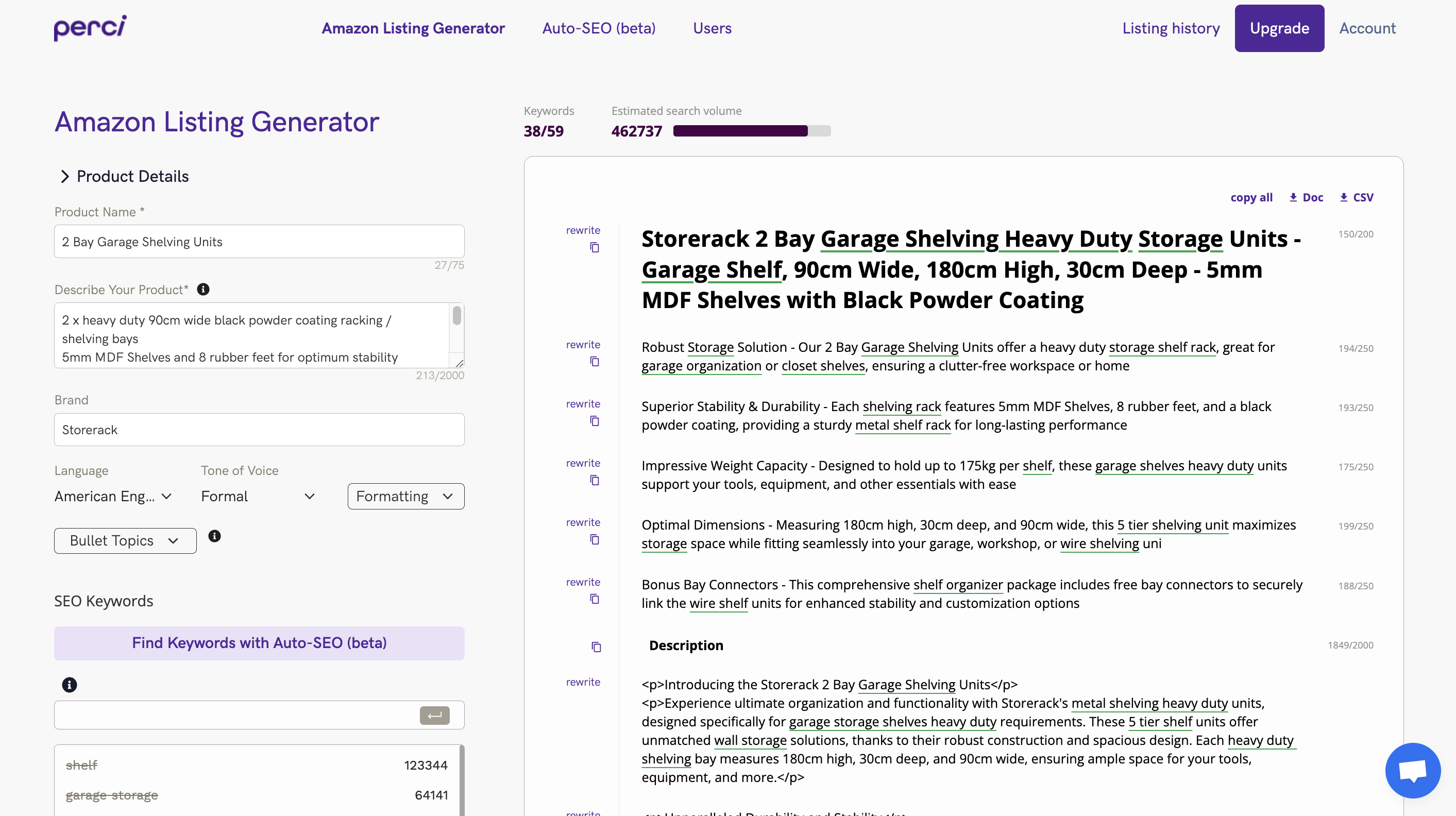
When you start selling on Amazon, there are so many things to learn: sourcing, branding, warehousing, logistics, setting up your Amazon seller account. And just when you’re ready to launch, now you have to actually write your product listing.
Never fear: below are my best tips for new sellers on avoiding the biggest mistakes and getting easy SEO wins.
Don’t feel like writing your listing? Get AI to write it in seconds.
Perci is the best AI writing tool for Amazon listings on the market with Amazon’s rules, restrictions and best practices all built in.
With Perci, you can skip the work and generate a professional, optimized listing with AI in a few minutes.

Okay—on to my favorite copywriting tips for Amazon listings.
1. Amazon SEO Starts In Your Title
Your listing title is the most important real estate you have. It’s the only thing shoppers read before they click into your listing. So before you can convert sales, your title has to convert clicks.
Your title is also the most important SEO information for Amazon ranking. Amazon wants to give shoppers the most relevant results for their search. So the first thing Amazon’s algorithm looks for is your title, because that’s a massive signal about what searches your product is really targeting.
So make sure to get your top 2-4 keywords in your title.
2. Beware of Keyword Stuffing
Whichever Amazon keyword tool you use for research, you’ll probably get a lot of keywords. Sometimes thousands.
Don’t panic! You don’t need to use all those keywords you find. In fact, you shouldn’t—that’s called ‘keyword stuffing’. Keyword stuffing is when you cram so many keywords into your listing that it reads like a string of random phrases, rather than something written by a real person.
If you keyword stuff, you may get a bit more traffic but your sales will suffer.
Instead, be smart about which keywords to target. Choose the top 3 or 4 for your title, and 2 for each bullet.
Note: Keyword stuffing in your title is up for debate. Titles are given so much importance in Amazon search that some sellers want to get as many keywords as possible there, at the cost of readability. Fair play.
3. Avoid Amazon’s banned phrases
Amazon has some basic ground rules about what you can and can’t say in your listing. These mostly relate to spammy, unhelpful or sales-y things that don’t help shoppers evaluate your product.
Phrases like, ‘Buy with confidence’, ‘Free shipping’ or ‘World’s best’ are 100% banned.
Amazon doesn’t publish an official list, but you can find a good list of banned phrases here.
4. Trigger Phrases: Proceed With Caution
Besides Amazon’s banned phrases, there are ‘caution’ words and phrases known to trigger an Amazon investigation into your listing. These often relate to category-specific claims like ‘antibacterial’ or ‘pest control’, or legally sensitive terms like ‘CBD’.
If these terms are central to your product, you can get clearance from Amazon to use them safely in your listing.
Annoyingly, Amazon doesn’t release a list of these trigger phrases so sellers are left guessing. The link of restricted phrases above has a partial list, but it’s best to search ‘Amazon restricted phrases’ along with your category to get a good idea.
5. Use Your Entire Product Description Field
Amazon gives you 2000 characters to use in your description (that’s the free text box below your bullets). This is a great opportunity to add mid-tier and long-tail keywords for extra traffic.
I see a lot of sellers get lazy here and only write a sentence or two. But is a huge block of text you can use to get more keywords.
The key is to format your description correctly (using <p> tags, which Amazon allows). These are how you can add line breaks to your description, so it’s readable for shoppers.
Other sellers don’t add a description because they’re using A+ content. A+ content covers up your description for shoppers on your listing page.
But this is crucial: even with A+ content, your description still indexes. So take full advantage of it.
6. Amazon SEO only indexes the firs 1000 bytes of your bullets
This little-known tip isn’t in Amazon’s official documentation, but has been confirmed by seller experiments: Amazon only indexes the first 1000 bytes in your bullets.
Note: ‘Bytes’ here are similar to characters, including spaces. You’ll see your byte count when you upload on Seller Central.
I see 2 common strategies with this 1000-byte limit. The first is to write 200-byte bullets, so all 5 bullets fully index.
The second strategy is clever, though: write 250-byte bullets, which means only your first 4 bullets will index. Then use your 5th bullet for any information that helps conversions, but isn’t important for search. This might be a 5th bullet about your brand, or sizing information.
7. Revisit and Optimize Your Listing
After you launch, it’s important to revisit and update your listing every 3 months or so.
If you’re getting a lot of the same questions from shoppers about your product, that’s a good clue that you need to add that info to your listing (or make it more prominent if it’s already there).
And perhaps more importantly: you can re-optimize your keywords. You’ll always have some keywords that do great, and others that do nothing. Prune these dead keywords and add some new ones that bring more traffic and sales.
Conclusion
Amazon copywriting goes far beyond what I’ve covered here. But my advice is to just get started. If you cover Amazon’s guidelines on Seller Central and the tips above, you’ll be way ahead of the pack in your listing content.
Want to use an AI Amazon tool that already has all of these tips and more? Try generating your listing with Perci. It’s an AI writing tool built specifically for Amazon listings. Perci has all the above guidelines built-in to every listing, as well as many more to give you a professional, optimized product listing in just a few seconds.